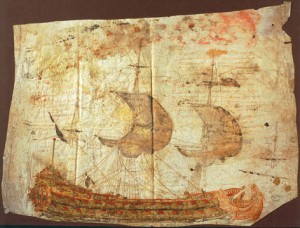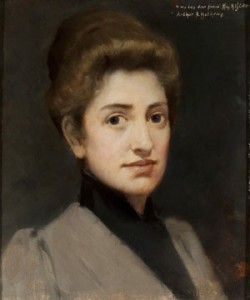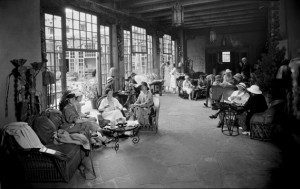When we think of the American West, our minds tend to conjure images of gunfighters, Indian wars and cattle barons. If we think of women at all, it’s most likely a saloon girl or Calamity Jane.
Historians know that’s hardly the distaff story of the West. From Native women who oversaw corn production and the building of adobe homes to Hispanic weavers, artists and property owners, to Anglo businesswomen, physicians and environmental stewards, the female side of the story of the West too often seems to fade into the Victorian wallpaper.
Up to now, that is.
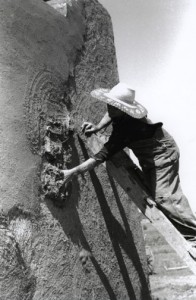
Spanish American Woman plastering, Chamisal, New Mexico, photograph by Russel Lee, 1940. Courtesy Library of Congress, Prints and Photographs Division, LC-USF33-012823-M5
This summer, the New Mexico History Museum begins filling in the historical gaps with four exhibitions focused on women past and present. Let’s round ’em up:
1. Home Lands: How Women Made the West, June 19-Sept. 11, a traveling exhibition from the Autry National Center in Los Angeles, features additional materials from the History Museum’s collections. The largest of the summer’s four exhibits, it sweeps across the centuries in three regions: the Rio Arriba of northern New Mexico; Colorado’s Front Rage; and the Puget Sound.
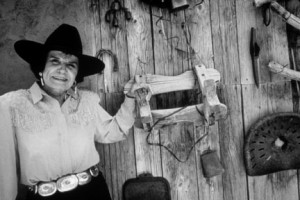
Evelyn Fite Tune, a longtime rancher outside Socorro, NM. Photo by Ann Bromberg, courtesy Palace of the Governors Photo Archives.
2. Ranch Women of New Mexico, April 15-Oct. 30 in the Mezzanine Gallery, highlights 11 women in this excerpt from an exhibit originally prepared by photographer Ann Bromberg and writer Sharon Niederman.
3. New Mexico’s African American Legacy: Visible, Vital, Valuable, May 15-Oct. 9 in the second-floor Gathering Space, tells the stories of the families who planted their roots and created a home in the Land of Enchantment following the Civil War.
4. Heart of the Home, May 27-Nov. 20 in La Ventana Gallery, spotlights historic kitchen items from the History Museum’s collections.
(Yes, they open at different times; that’s a reality of what it takes to mount an exhibition.)
“Since its opening in 2009, the New Mexico History Museum’s exhibits have included the stories of men, women and children – a conscious effort on our part to broaden the telling of history,” said museum director Frances Levine. “This summer’s exhibits highlight that commitment by focusing squarely on the contributions made by women that don’t begin and end with popular Western stereotypes.”
So you won’t find Miss Kitty or Calamity Jane or even Santa Fe’s own legendary madame, Dona Tules, in any of the exhibits. Instead, their shared focus is the universal desire to set down roots and create that place called “home.” That seemingly simple act is “a potent way of changing the world,” say Home Lands curators Virginia Scharff and Carolyn Brucken. Home Lands puts women at the center of that focus for a simple reason, the women write in their companion book: “Seeing women in history makes history look different.”
Among the women you will see in the exhibits:
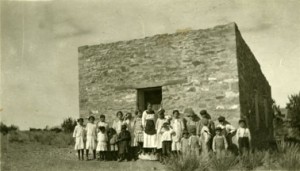
Fabiola Cabeza de Baca in front of New Mexican schoolhouse, photographer and date unknown. Fabiola Cabeza de Baca Gilbert Photograph Collectioon, Center for the Southwest Research, University of New Mexico
Fabiola Cabeza de Baca. A Las Vegas, NM, native, this teacher and writer elevated both the art and science of homemaking from the Depression forward, blending traditional practices with modern-day conveniences. Beginning in the 1950s, her expertise went global when she started home-economics programs in Central and South America for the United Nations and became a trainer for the Peace Corps. Her story is included in Home Lands.
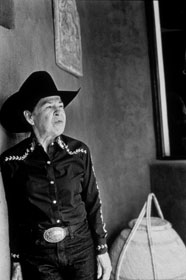
Legendary cowgirl Fern Sawyer. Photo by Ann Bromberg, courtesy of the Palace of the Governors Photo Archives.
Fern Sawyer. New Mexico’s best-known cowgirl spent 77 years living up to her motto: “Do all you can as fast as you can.” An inductee into the Rodeo Cowboy Hall of Fame, Cowgirl Hall of Fame and National Cutting Horse Hall of Fame, Sawyer passed away in 1993, still with her boots on, still in the saddle. Ranch Women of New Mexico includes her story.
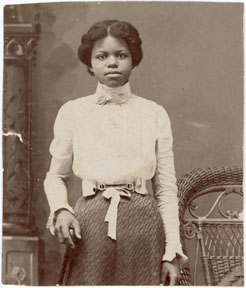
Clara Belle Drisdale. Photo courtesy New Mexico State University Archives.
Clara Belle Drisdale Williams. In 1937, she became the first African American to graduate from New Mexico State University. After a career of teaching others, she received an honorary law degree from NMSU in 1980, along with an apology for how she was treated as a student. You’ll find her story in New Mexico’s African American Legacy.
Other New Mexico women in Home Lands: Pueblo potter Maria Martinez; painter Pablita Velarde; photographer Laura Gilpin; archaeologist Bertha Dutton; santera Gloria Lopez Cordova; Santa Clara Pueblo artist Nora Naranjo Morse; and poet and playwright Joy Harjo.
The Autry drew on its extensive collections to organize the exhibit, but also purchased must-have items, including Pablita Velarde’s monumental mural, Green Corn Dance. It’s impressive even in a computer-screen’s small scale:

Artifacts range from a 1,200-year-old Mogollon metate to a 20th-century station wagon, textiles, clothing, pottery, paintings, photographs, sculpture, books, and an art piece made of computer components by contemporary artist Marion Martinez.
To kick things off, the Museum of New Mexico Foundation is holding a $200-a-person party called Celebrate on Saturday, June 18. Put on your fancy Western wear and enjoy fine wines and creative cuisine in the Palace Courtyard. Learn more, including how to buy tickets by clicking here.
Throughout the summer, we’ll have special lectures, workshops and symposiums to further deepen your knowledge of women in the West. All these events are free and in the History Museum auditorium unless otherwise noted:
Sunday, June 12, 2 pm: Symposium on “The Journey of the African American North,” including stories from Santa Fe and Española.
Sunday, June 26, 2 pm: “Captive Women in the Slave System of the Southwest Borderland.” Lecture by James F. Brooks, president of the School for Advanced Research and prize-winning author of Captives & Cousins: Slavery, Kinship, and Community in the Southwest Borderlands.
Sunday, July 10, 2 pm: “Fabiola Cabeza de Baca and The Good Life.” Lecture by Tey Diana Rebolledo, regents professor at the University of New Mexico.
Sunday, July 17, 2 pm: “Moving Around to Settle In: Women of the Plains and Range.” Lecture by Virginia Scharff, co-curator of Home Lands and director of UNM’s Center for the Southwest.
Monday, 9 am to 4:30 pm, and Tuesday, 9 am to 12 pm: “Planting Seeds: Home, Healing and Horticulture.” Conference in collaboration with the New Mexico Committee of the National Museum of Women in the Arts. $25. (Details pending.)
Sunday, Aug. 7, 2-5 pm: “Homespun: Northern New Mexico Spinning and Weaving Techniques.” Members of the Española Valley Fiber Arts Center demonstrate Pueblo, Navajo and Spanish techniques in the Palace Courtyard.
Friday, Aug. 12, 6 pm: “Through Her Eyes: An American Indian Woman’s Perspective.” Lecture by Eunice Petramala, park ranger at the Sand Creek Massacre National Historic Site.
Sunday, Sept. 25, 2 pm: Symposium on “Entrepreneurship in the African American Community,” from barbers to caterers, mechanics to artists.
Home Lands is generously supported by Cam and Peter Starret, Ernst & Young, Eastman Kodak Company, the National Endowment for the Humanities, Unified Grocers, Wells Fargo, KCET and the Friends of the Autry. Local support is provided by Stanley S. and Karen Hubbard, Dr. Ezekiel and Edna Wattis Dumke Foundation, the Museum of New Mexico Foundation, the Palace Guard and the Montezuma Ball.

